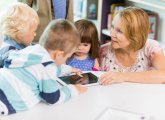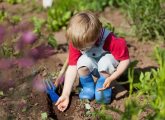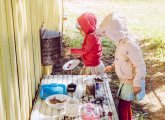Use these EYFS literacy activities to immerse children in the language of everyday life and lay the foundations for lifelong learning, says Sally Neaum…
Young children who have rich experiences of spoken language and engagement with print in their everyday lives build strong foundations on which they can build the observable skills of reading and writing. Creating a literate environment in your Early Years setting helps all children build this strong foundation for literacy.
A literate environment is one where there are high levels of talk. People say “more than is necessary” (Neaum, 2012). Reading and writing are everyday, purposeful activities.
Speaking and listening are the basis of becoming literate. So it’s vital that, alongside engaging children in early literacy practices, we maintain a strong emphasis on speaking.
We know that children acquire and develop spoken language by being surrounded by talk. There is a powerful link between the quantity and quality of language we expose children to and the quality and quantity of their language (Risley and Hart, 2006).
Children need to hear and use talk in meaningful daily contexts. Young children learn about reading and writing as they observe and become actively involved in real, purposeful literacy activities in their everyday lives.
There are many opportunities to engage children in talk and EYFS literacy activities at home. What is important is that we encourage children to notice how literacy is used in our everyday lives. Here are some reading and writing ideas to share with parents:
It’s also essential that we talk to children in ways that go beyond a functional use of language. Encourage parents to engage in discussion, explanation, questioning and pondering.
A packet of herb seeds fell from a food magazine that Mia was reading. Her daughter noticed them and asked what they were.
Mia pointed out the picture on the front and explained about plants and how they grew from seeds. Her daughter was keen to plant them. Mia read the packet instructions to her daughter and they talked about what they would need to plant the seeds.
Together they collected what they would need and set it all up in the kitchen. Mia then read the instructions out one by one as they planted the seeds.
This is an example of embedding reading and writing in an everyday activity. As Mia engages her daughter in this activity she is talking to her. She is modelling reasons for reading and writing. T
This talk and engagement with literacy practices will enable her daughter to develop a range of skills and concepts necessary to becoming literate.
There are many ways we can involve children in authentic EYFS literacy activities at nursery:
And, as at home, alongside this we need to talk in ways that go beyond organisational talk and brief social interactions. We should actively engage children in playing with language and talk that uses commentary, discussion, questioning, pondering and explanation.
In settings, creating a literate environment means ensuring that children are surrounded by and engaged with talk and print. You can achieve this in a number of ways:
A storyteller visited nursery and told tales of knights, princesses and castles. After, the children wanted a castle as the role-play area. Initially, staff and children talked about what they would need to set up a castle in the nursery.
Staff collected books about castles and put them out with large sheets of plain paper. They encouraged children to come and record their ideas using the books and ideas from the discussion.
A member of staff helped the children to record their ideas in pictures, symbols and emergent writing. In addition, staff displayed websites on the computer. Children used these to find out information, look at pictures, and download and print information.
The practitioner then put the items that the children had suggested into a list. At group time, the children and staff read the list together. They decided which of these resources they already had in the nursery and which they would need to acquire.
One of the children highlighted the list in different colours to show what they already had and what was needed.
As children are drawn into literacy practices in their everyday lives they learn about both the forms and functions of reading and writing.
They come to know what we use reading and writing for (the functions), and how we read and write (the forms).
As we read and write for a variety of purposes and engage children in this, we model different functions of literacy for children. For example, they come to know that we read and write:
By engaging with spoken language and exploring reading and writing in real, everyday contexts, children begin to develop important concepts necessary. For example, they learn about the relationship between speech and print; that writing is the setting down, or recording, of speech (as squiggles-on-a-page).
They learn that reading is decoding writing (the squiggles-on-a-page) into speech. They also learn print-related terms, such as ‘letter’ and ‘word.’
In addition, by observing people read and write they come to know that, predominantly, we track left to right and top to bottom when we read and write.
Tracking left to right and top-to-bottom is not always the case. For example, tracking is different when reading from some websites and in some children’s books that use words and text creatively.
Modelling reading in these different ways enables children to come to know that there are, occasionally, different ways in which we track when we read and write.
Understanding forms and functions of literacy are important concepts for children as they become readers and writers.
It enables them to understand why we need to read and write, and some of the ways in which we read and write.
This means that when they move to more formal literacy learning they have an understanding of reading and writing as meaningful activities.
Children at a setting love playing ‘police’. They play out elaborate narratives all ending with the police chasing ‘baddies’, arresting them, and taking them down to the police station.
The staff provided dressing up clothes and equipment. With the children’s help, they created a police station and cells. This included opportunities for reading and writing through labels, signs, directions, name badges, posters, paper and pens, and a computer.
Staff enhanced play by joining in and introducing specific vocabulary, such as ‘suspect’, ‘charge’, ‘interview’ and ‘crime scene’.
They also introduced the idea of using digital cameras and the computer to take pictures of the crime scene and suspects and label them.
Staff also introduced the idea of using police notebooks to record what happened at the crime scene, and what the suspects said when interviewed at the police station.
Sally Neaum is a lecturer in Early Childhood, and teaches Primary English in initial teacher training. She has worked as a nursery and primary school teacher and as an advisor in early years and inclusion. She has an M.Ed in Educational Psychology and Special Educational Needs. Her doctoral research was in the pedagogy of early literacy.

5 Ways to Use Tech in the Early Years Classroom
Editors picks

Looking after the environment – 8 ideas for Early Years
Editors picks

Messy play activities – Grasping new skills
Editors picks
